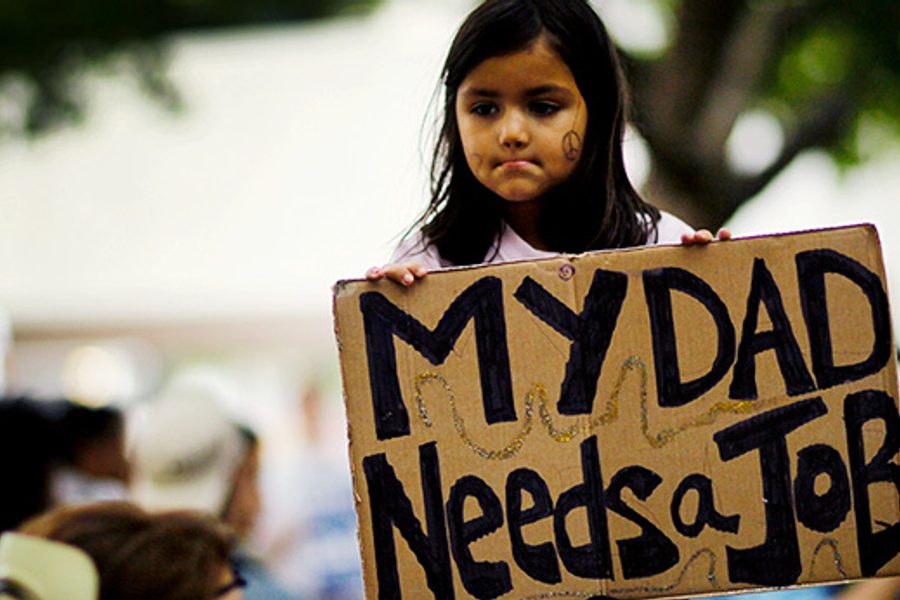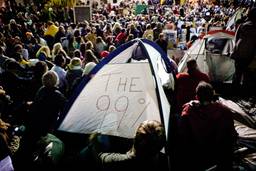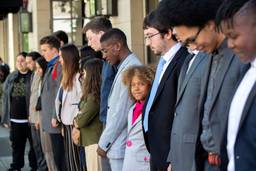An Occupy Road Trip
In cities and towns across the nation, protesters are rejecting the status quo—but not necessarily capitalism.
Arun Gupta

Editor’s note: In October, journalist Arun Gupta spent a few weeks traveling from New York City to Detroit to visit smaller Occupy sites like Youngstown, Ohio, and Allentown, Pa. What he found was “a mix of broad, even contradictory politics” united under the banner of the “99%.”
A trope about mass movements is that they spring up from nowhere. That appears to be the case with the Occupy Wall Street movement, which went from an idea to a social force that reshaped the national debate in barely a month.
It may appear to be rootless, but the occupation of the Wisconsin state capitol in February and smaller successful episodes – like the Republic Windows and Doors sit-in in Chicago in December 2008, university students taking over part of a New School university building in the same month and the three-week “Bloombergville” encampment in New York City this past June – all influenced or shaped the Occupy Wall Street movement, which sprouted out of Manhattan’s Zuccotti Park on September 17.
With its anarchist social norms and emphasis on economic issues and horizontal decision-making, the Occupy movement is also the heir to the “alter-globalization” movement that came to prominence during the 1999 WTO ministerial meetings in Seattle.
Of course, the Occupy movement was most profoundly influenced by the wave of democratic uprisings and public occupations that have stretched from Egypt, Tunisia, Bahrain and Syria to Spain, Greece, Chile and Puerto Rico over the last year.
This movement began as an anti-capitalist revolt, and at Liberty Park the anti-capitalism current is strong. In other large occupations I have visited, such as Chicago, Detroit, Philadelphia and Pittsburgh, anti-capitalism is also a recurring theme. But in each one there is also a mix of broad, even contradictory politics. Many occupiers told me they still see a central role for capitalism, and that the main problem is the “system no longer works” and that the “American Dream is dead.”
It is impossible to track every active occupation, but Occupytogether.org listed 2,447 Occupy “meet-ups” at the start of November. As to how many involve 24-hour encampments – one source is Cryn Johannsen of the All Education Matters blog, who compiled a database of city mayors to contact in case a specific occupation is attacked. That list runs to about 350 cities, including 44 in California, 12 in Indiana, six in Kentucky and four in Maine.
Many are small, a dozen or fewer people occupying central plazas in rust-belt cities like Toledo and Youngstown, Ohio, and Allentown, Pa. And they spread like a rhizome from town to town.
Adam Santo, a fresh-out-of-college resident of Allentown who was laid off from his job at a local bank in February, used Facebook and thousands of flyers to catalyze his city’s occupation in early October. On the afternoon of October 18, about a dozen Occupiers and supporters were stationed in central Allentown waving protest signs at passing motorists who regularly responded with supportive honks and waves. After Occupy Allentown began, Santo says, other occupations sprang up in nearby Bethlehem and Easton, and farther away in Scranton, Lancaster and Wilkes-Barre.
Many occupiers decline to offer specific demands, and that has helped this movement succeed by focusing outrage at the concentration of power and wealth among the 1%. The vagueness about demands allows everyone to see their particular issue as equivalent to everyone else’s, thus creating a broad movement that even extends to the right despite the anti-capitalist orientation. In various cities, from D.C. to Detroit, I have encountered occupiers who call themselves Republicans or conservatives or sound exactly like Tea Party members in espousing values of self-reliance, hard work, community and locally based solutions, and declaring their opposition to centralized power and government.
Nonetheless, outside the major cities, concrete demands percolate to the surface. In Toledo, a city rich in abandoned housing, Candice Milligan, a 30-year-old trans woman who lost her job as an auto mechanic two years ago, says jobs and home foreclosures are important issues.
In Youngstown, Chuck Kettering Sr., 56, calls himself “the poster boy for the rust belt.” He says NAFTA was “one of the biggest blows to our local economy.” In 1973, he started working for U.S. Steel, laboring in the blast furnace area at two different plants that shuttered. That was followed by auto-parts maker Delphi, which he left in 2008 after his pay was due to be slashed from $28 an hour to $16.
His son, Chuck Kettering Jr., opposes Republican Gov. John Kasich’s privatization plan for the Ohio Turnpike, hydrofracking in Mill Creek Park – what he calls the “jewel of the area” – Issue 2, a ballot initiative that would strip public sector employees of collective bargaining rights, and Issue 3, an initiative that would exempt Ohio from the pending national healthcare law.
Karen Joseph, a 59-year-old Youngstown native, mentions the new national healthcare law as a major concern, explaining that her family spends about $800 a month on health insurance, one-third of their income. Joseph is one of many who say good-paying jobs need to return; she has been unsuccessfully trying to find work for the last five years.
In both Youngstown and Allentown, occupiers say some of the only jobs available are in call centers, but high unemployment means companies prefer to hire college graduates to answer phones.
I ask occupiers if the government should provide jobs. In Baltimore, Joe Yingling, a 40-year-old software developer, supports the local occupation but maintains, “I don’t think we can rely on the government for everything.” In Philadelphia, 28-year-old Adam Hill who referred to himself as “a failing contractor,” said the problem was “jobs being shipped overseas and tax breaks for corporations. “
At Occupy Detroit, I talk to Jane, one of the main organizers in the kitchen. “If we had people giving us jobs, we wouldn’t be here,” she says. She suggests that the Occupy movement could provide employment. In a city where empty storefronts and shells of skyscrapers litter downtown, the need for work is extreme. A 2009 estimate puts Detroit’s real unemployment rate at 44.8 percent. Homeless and poor people form a large contingent in the camp at Grand Circus Park.
Jerry Edwards, 58, says he started working as a teenager in factories, including 14 years at the Ford Saline plant in Ypsilanti making dashboard panels. Leaning on a cane and with limited work prospects because of kidney damage he suffered as a child, Edwards’ story is not unusual, but through the Occupy movement he now has a space to tell it – and to be heard.
In visiting 10 occupations in the Northeast and through the Great Lakes, I have met homeless veterans, Latina mothers, gay activists, African-American youth, retired professors, anarchists, nurses, unemployed union members, students, families, socialists, Native Americans, conservatives and full-time workers representing dozens of different occupations. We should thank the ruling elite: They have made class relevant again. What is so powerful about this moment is that so many different groups of people have banded together under the banner of the “99%.”
At Liberty Park, L.A. Kaufman, a long-time activist and parent of two children, says, “What this movement has done in a short period of time is astonishing. It’s sparked a national conversation about the concentration of wealth, and has the plutocrats quaking in their boots and Obama nervous. Who needs demands when you can do that?”








